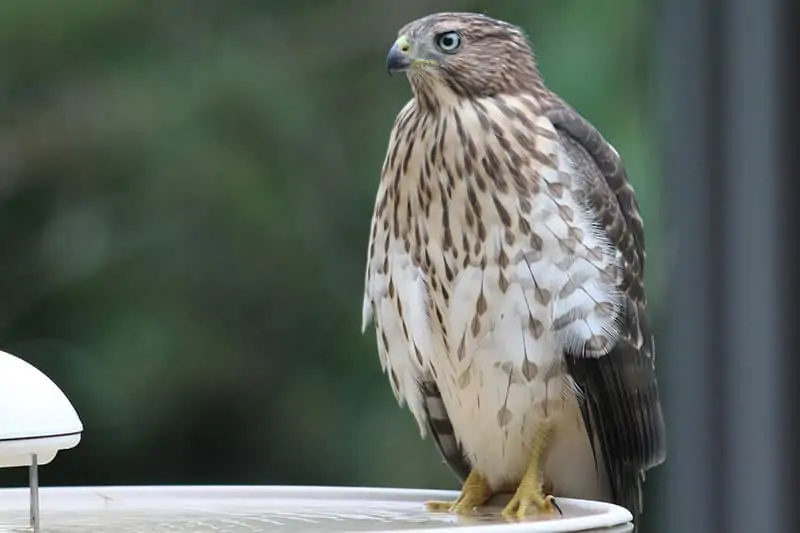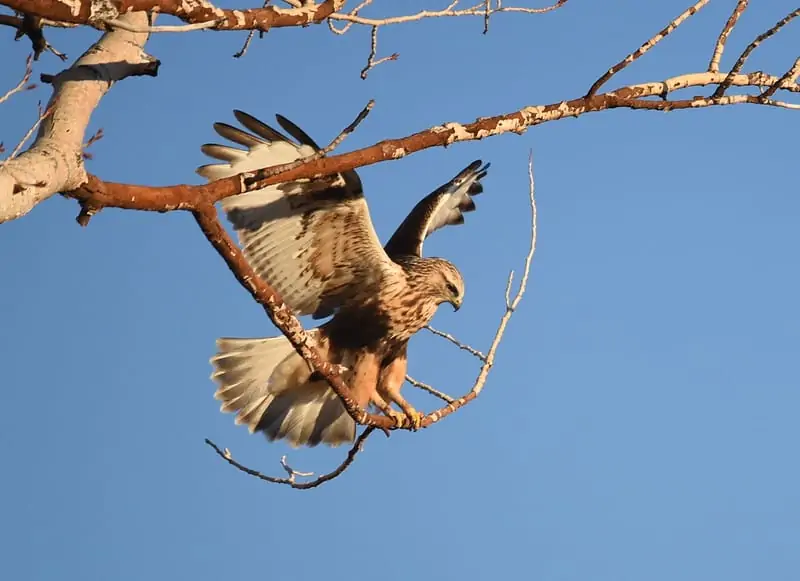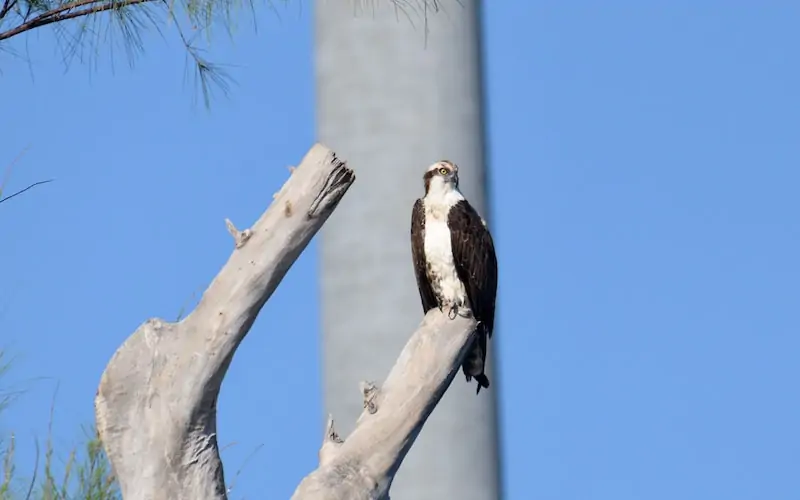Despite its status as the biggest metropolis in the United States, New York is also home to a diverse collection of birds of prey. New York has an abundance of habitats that support many of north americas owls, hawks, falcons, and eagles, from the Adirondacks to the Great Lakes to the Hudson River and all of the forests in between. We’ll take a closer look at the New York hawks today.
8 SPECIES OF HAWKS IN NEW YORK
In the spring and fall, many hawks migrate. The fall hawk migration in New York attracts a large number of birdwatchers.
In New York during the fall, there are a number of excellent locations to “hawkwatch:
- John Boyd Thacher State Park
- Derby Hill Bird Observatory, Oswego County
- Chestnut Ridge Hawk Watch, Mt. Kisco
- Franklin Mountain Hawk Watch, Davenport
1. NORTHERN HARRIER

Scientific name: Circus hudsonius
Length: 18.1-19.7 in
Weight: 10.6-26.5 oz
Wingspan: 40.2-46.5 in
The northern harrier, a medium-sized hawk with its wings held upwards in a V formation, is recognized for flying. Females and immatures are a warm cinnamon brown, while males are a silvery gray to gray-brown. A bright white rump patch at the top of their tail is one good field mark to look for. They have a hawk’s face that some people believe resembles an owl when they are up close. Northern Harriers, like owls, are known for their hearing when hunting prey like mice and voles in fields, which they locate using their ears. They have ears that are compartmentalized, which helps to direct sound.
Male Northern Harriers have earned the nickname “the gray ghost” for their beautiful plumage, owl-like face, flying fast and low over fields. Throughout the spring and summer, Northern Harriers may be found in New York, with year-round populations around the Great Lakes.
2. SHARP SHINNED HAWK

Scientific name: Accipiter striatus
Length: 9.4-13.4 in
Weight: 3.1-7.7 oz
Wingspan: 16.9-22.1
Sharp shinned hawks are about the size of a large dove and have sharp, pointed beaks. Their upperparts are dark slate gray, and their chest is banded in orange. Immature birds have a brownish-brown breast with brown streaking. These hawks are more common in the autumn and winter, as they prefer to nest in thick woods throughout the spring and summer. These little hawks, which stalk backyard bird feeders on a regular basis, are famous for capturing smaller birds in flight. They, on the other hand, are not known for swallowing feathers and will carry their catch to a perch to pick them off. The bigger Coopers hawk, which looks remarkably similar, is frequently mistaken with them.
3. COOPERS HAWK

Scientific name: Accipiter cooperii
Length: 14.6-17.7 in
Weight: 7.8-24.0 oz
Wingspan: 24.4-35.4 in
While they are somewhat bigger, around crow-sized, both adult and juvenile Coopers hawks look a lot like Sharp Shinned hawks. They’ll be coming around your back yard bird feeder to pounce on little birds, just like you do. Coopers hawks may sustain serious injuries while hunting for birds, diving into shrubs and branches or flying through tree limbs at a breakneck pace. Because of the presence of doves and pigeons, their population seems to be adapting to both suburban and urban environments. During the breeding season, Cooper’s hawks can be found year-round in southern New York, but are scarce in northern New York.
4. RED-SHOULDERED HAWK

Scientific name: Buteo lineatus
Length: 15-24 inches
Weight: 1.5 pounds
Wingspan: 35-50 inches
The breeding season is spent in New York, with some birds seen year-round near the southern tip of the state boarding Connecticut and New Jersey. The red-Shouldered hawk is found all across the state during the breeding season. Their call, a loud “kee-aah” that they repeat multiple times in secession, will commonly alert you of their presence. These hawks may be discovered in any woodland, even in suburbs with enough tree-lined locations. They adore the woodland and can be found there. In wooded areas or around the edges of ponds, they prefer to hunt for prey perched on a tree limb. Small mammals, snakes, and amphibians are the main foods for these animals. In my yard, I captured a terrific video of a Red-Shouldered Hawk calling.
5. BROAD-WINGED HAWK

Scientific name: Buteo platypterus
Length: 13.4-17.3 in
Weight: 9.3-19.8 oz
Wingspan: 31.9-39.4 in
During the summer, broad-winged hawks live in the east, but return to South America for the winter. Their migratory displays are perhaps their most well-known feature. They may gather in huge flocks known as “kettles” as they travel south in the autumn. They are most visible during the breeding season, since they spend it inside forests and are much less evident throughout the spring and fall migrations. They have brown barring and are small in stature. Their wing undersides are light, with a black and white barring tail, and their wing undersides are light with a dark brown band along the edge.
6. RED-TAILED HAWK

Scientific name: Buteo jamaicensis
Length: 17.7-25.6 in
Weight: 24.3-51.5 oz
Wingspan: 44.9-52.4 in
New York’s most prevalent hawk is the Red-tailed Hawk. They can be found all year in most parts of the state, but in the far north, they are only seen during the summer. These are big, powerful brown-feathered hawks that are lighter on the underside. The tail of an adult is rusty red. They’re usually seen soaring over fields or perched in high locations, constantly scanning the ground for food.
They prefer to lounge in the branches of trees along the roadway or sit on top of telephone poles. Mice, voles, squirrels, chipmunks, and rabbits are among the small mammals they feed on. Their shrill cry is often employed to portray hawks and even eagles in television and cinema.
7. NORTHERN GOSHAWK

Scientific name: Accipiter gentilis
Length: 20.9-25.2 in
Weight: 22.3-48.1 oz
Wingspan: 40.5-46.1 in
New York hosts a year-round population of Northern Goshawks, however they are mostly a passing species. They avoid highly populated places and prefer to dwell inside huge forest tracks, hence they remain mysterious and unseen. They have a dark gray back with gray striped chest and are mostly gray in color. With a prominent white “eyebrow” and orange-red eyes, their face is striking. They’ll attack anybody who gets too close to their nests, and they’ll fiercely defend them. Goshawks are superb hunters who can catch prey rapidly. They were originally trained by falconers for their skill, and their name comes from the Old English term “goose hawk,” which means “bird catcher.”
8. ROUGH-LEGGED HAWK

Scientific name: Buteo lagopus
Length: 18.5-20.5 in
Weight: 25.2-49.4 oz
Wingspan: 52.0-54.3 in
During migration or soaring over open fields and marshes during the winter, rough-legged hawks do not spend their breeding season in New York, but they can be found there. They only breed in the far northern tundra, and spend their summers further north. The feathers on the legs of rough-legged hawks grow all the way down to their feet, giving them their name. The only raptors with fully feathered legs in the United States are these three.
OSPREYS IN NEW YORK
We thought we should include Osprey’s in this article because they were once classified as hawks, despite the fact that they aren’t technically hawks. The ospreys have been placed in their own group because they are so unique. Ospreys were formerly categorised as “similar hawks,” but are now considered a distinct family, according to Audubon.org.
They are virtually identical across the globe, with minor variations in certain areas. Osprey toes are similar to hawks in that they all have the same length and rounded talons. They also have a reversible outer toe, which we’ll talk about again later on.
OSPREY

Scientific name: Pandion haliaetus
Length: 21.3-22.8 in
Weight: 49.4-70.5 oz
Wingspan: 59.1-70.9 in
Ospreys are exclusively dependent on fish, so they’re usually spotted near lakes with plenty of it. Freshwater rivers and lakes, as well as saltwater beaches, are all examples of this. They stretch their toes out in front of them as they descend towards the water to catch fish. They have a reversible outer toe, which enables them to grip both sides of an item when hanging on to slippery fish, unlike other hawks.
At the tops of trees, rock outcroppings, and even utility poles, they construct enormous nests made of sticks. To help in the preservation and promotion of excellent nesting places, many states will construct various platforms for Ospreys. During the spring and summer, you may find Osprey in New York.

